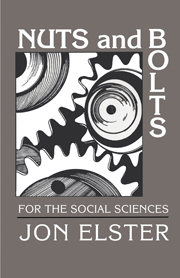I - Mechanisms
Published online by Cambridge University Press: 05 June 2012
Summary
THE emphasis in this book is on explanation by mechanisms. It offers a toolbox of mechanisms – nuts and bolts, cogs and wheels – that can be used to explain quite complex social phenomena.
The social sciences, like other empirical sciences, try to explain two sorts of phenomena: events and facts. The election of George Bush as president is an event. The presence in the electorate of a majority of Republican voters is a fact, or a state of affairs. It is not immediately obvious what is more fundamental, events or facts. One might, quite plausibly, explain Bush's victory by the Republican majority. One might also, no less plausibly, explain the Republican majority as being the result of a series of events, each of which took the form of belief formation by an individual voter. The second perspective is the more fundamental: explaining events is logically prior to explaining facts. A fact is a temporal snapshot of a stream of events, or a pile of such snapshots. In the social sciences, the elementary events are individual human actions, including mental acts such as belief formation.
To explain an event is to give an account of why it happened. Usually, and always ultimately, this takes the form of citing an earlier event as the cause of the event we want to explain, together with some account of the causal mechanism connecting the two events. Here is a simple, paradigmatic example.
- Type
- Chapter
- Information
- Nuts and Bolts for the Social Sciences , pp. 3 - 10Publisher: Cambridge University PressPrint publication year: 1989
- 2
- Cited by



